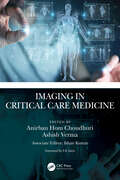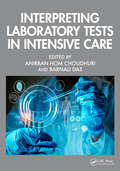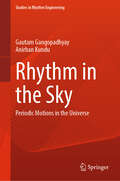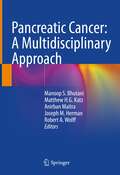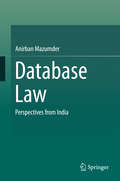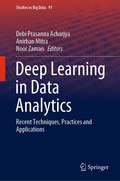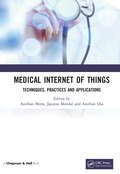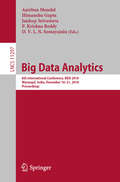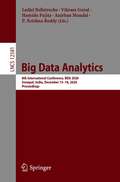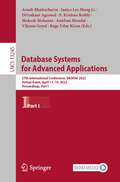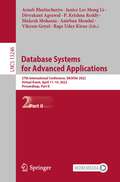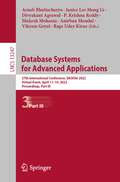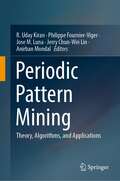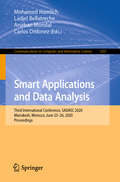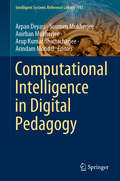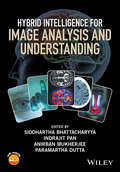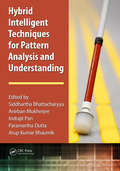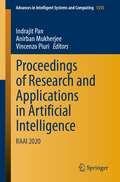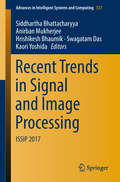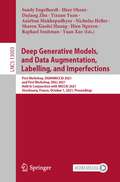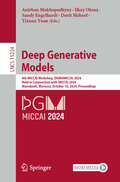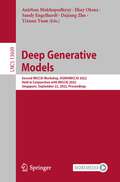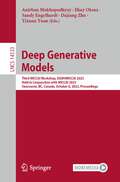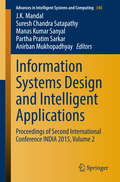- Table View
- List View
Imaging in Critical Care Medicine
by Ashish Verma Anirban Hom Choudhuri Ishan KumarImaging in critically ill patients is a ubiquitous but challenging line of investigation for the physician as accurate interpretation is often difficult as patient cooperation during the procedure is grossly compromised, and the resultant image is often suboptimal. This book provides details on principles of imaging and the diagnostic hallmarks of common diseases to assist in correct interpretation. It contains guidance to overcome the deficiencies observed during the performance of bedside imaging and equipment handling and addresses the rationale for various procedural/management and imaging approaches. This is a useful companion for most doctors and trainees working in critical care settings. Key Features • Features case-based scenarios in critical care as well as a section on tropical diseases• Appeals to a wide audience of trainees and consultants of critical care medicine, internal medicine, anaesthesiology, pulmonary medicine and those working in the ICU, due to its clinical relevance• Reduces the dependency on the radiologist and helps the physician save time, enhancing the quality of patient care
Interpreting Laboratory Tests in Intensive Care
by Anirban Hom Choudhuri and Barnali DasThis book incorporates a wide variety of clinical conditions requiring admission to the intensive care unit that necessitate timely performance of diagnostic tests and their correct interpretation to guide the best treatment. It tries to translate complex physiological principles and diagnostic algorithms into a clinically relevant format that can be easily understood by clinicians. It also explains at length the key clinical inputs to be acquired by laboratory physicians before reporting the results and tries to solve the common dilemmas leading to misinterpretation. The importance of every detail, from sample collection and dispatch to correlation of clinical state report, has been adequately explained with suitable examples and proper explanations.
Rhythm in the Sky: Periodic Motions in the Universe (Studies in Rhythm Engineering)
by Gautam Gangopadhyay Anirban KunduThis book provides a brief and pedagogic introduction to a variety of topics, with a common motif that they all occur, in some way or other, in “the sky”, and involve some sort of “rhythm”. Sky is not just the inside of a dome; there are many strata, each with its own beauties and mysteries. As we go up, the atmosphere thins out and ends, and we move into the space, into the realms of planets, asteroids, and comets, and even further, beyond the solar system into the vast Milky Way galaxy. This is where the night sky comes in, with all its twinkling stars, the stars in our own galaxy. We must use telescopes to explore further. In this book, we will start from the ancient astronomers and how they studied the motion of earth through space. Study of planetary orbits, from Kepler and Newton to Einstein, had been fascinating. We will try to take the reader through the wonderful worlds of the cepheid variables and pulsars to the strange oscillations of the neutrinos and the new eye to look at the universe, namely the gravitational waves. The book stops at the discovery of the black hole at the center of our galaxy, but that is just because we must stop somewhere, or the assortment could go on ad infinitum. Some of these topics are highly mathematical in nature, but we will try to avoid the complicated mathematics as much as possible, without compromising with the rigor.
Molecular Genetics of Pancreatic Cancer
by Diane M. Simeone Anirban MaitraPancreatic cancer is a formidable disease, and advances in early detection and improved therapeutics have been slow to come forth. With new advances in molecular genetics in the field of pancreatic tumorigenesis, it is an opportune time to use these recent discoveries to enhance our understanding of pancreatic cancer biology and to improve outcomes in patients. In this volume, leading experts in the field shed light on these findings describing the mutational landscape of pancreatic cancer, including new inroads into our understanding of familial pancreatic cancer, epidemiology, the biology of K-ras signaling, and the emerging contribution of epigenetic alterations to disease initiation and progression. The distinctive pancreatic cancer-stroma ecosystem as determined by the dynamic interplay of inflammation, hallmark mutations, EMT, and cancer stem cells is described, and implications of these interactions in the context of development of novel, personalized therapeutic options are explored.
Pancreatic Cancer: A Multidisciplinary Approach
by Anirban Maitra Joseph M. Herman Manoop S. Bhutani Matthew H. G. Katz Robert A. WolffThis book provides a comprehensive, state-of-the-art overview of pancreatic cancer. The text presents new data about risk factors and genetic predisposition for pancreatic cancer, highlights current screening strategies and preliminary results, and reviews diagnosis and staging of pancreatic cancer, with a focus on imaging evaluations, laparoscopy, endoscopic ultrasound-guided biopsies, and biomarkers. The book also spotlights emerging paradigms in pancreatic cancer management, such as minimally invasive surgical approaches and emerging radiation approaches, and provides valuable insight into the role of nutrition and early integration of supportive/palliative care for pancreatic cancer patients. Written by experts in the field, Pancreatic Cancer: A Multidisciplinary Approach is an invaluable resource for physicians and researchers with an interest in pancreatic cancer.
Database Law: Perspectives from India
by Anirban MazumderThis book focuses on database law (a branch of intellectual property law) and further explores the legal protection currently available for data and data-related products in India. It offers a comparative study of the position of copyright law in protecting databases in the US and EU, while also presenting responses from the Indian database industry and its aspirations regarding the role of copyright law in database protection. India is undoubtedly leading the way as a knowledge economy. Its strengths are its information technology capability and its knowledge society, as well as its booming database industry aspects that also necessitate the study of the role of law, as well as the protection of data and databases, in India. This book examines the growing importance of copyright law for protecting databases as well as for ensuring access in information societies. The book concludes with a discussion of key principles to be kept in mind in the context of drafting legal regimes for databases in India that will both benefit the database industry and ensure accessibility. "
Deep Learning in Data Analytics: Recent Techniques, Practices and Applications (Studies in Big Data #91)
by Noor Zaman Debi Prasanna Acharjya Anirban MitraThis book comprises theoretical foundations to deep learning, machine learning and computing system, deep learning algorithms, and various deep learning applications. The book discusses significant issues relating to deep learning in data analytics. Further in-depth reading can be done from the detailed bibliography presented at the end of each chapter. Besides, this book's material includes concepts, algorithms, figures, graphs, and tables in guiding researchers through deep learning in data science and its applications for society.Deep learning approaches prevent loss of information and hence enhance the performance of data analysis and learning techniques. It brings up many research issues in the industry and research community to capture and access data effectively. The book provides the conceptual basis of deep learning required to achieve in-depth knowledge in computer and data science. It has been done to make the book more flexible and to stimulate further interest in topics. All these help researchers motivate towards learning and implementing the concepts in real-life applications.
Medical Internet of Things: Techniques, Practices and Applications
by Anirban MitraIn recent years, the Medical Internet of Things (MIoT) has emerged as one of the most helpful technological gifts to mankind. With the incredible development in data science, big data technologies, IoT and embedded systems, it is now possible to collect a huge amount of sensitive and personal data, compile it and store it through cloud or edge computing techniques. However, important concerns remain about security and privacy, the preservation of sensitive and personal data, and the efficient transfer, storage and processing of MIoT-based data. Medical Internet of Things: Techniques, Practices and Applications is an attempt to explore new ideas and novel techniques in the area of MIoT. The book is composed of fifteen chapters discussing basic concepts, issues, challenges, case studies and applications in MIoT. This book offers novel advances and applications of MIoT in a precise and clear manner to the research community to achieve in-depth knowledge in the field. This book will help those interested in the field as well as researchers to gain insight into different concepts and their importance in multifaceted applications of real life. This has been done to make the book more flexible and to stimulate further interest in the topic. Features: A systematic overview of concepts in Medical Internet of Things (MIoT) is included. Recent research and some pointers on future advancements in MIoT are discussed. Examples and case studies are included. It is written in an easy-to-understand style with the help of numerous figures and datasets. This book serves as a reference book for scientific investigators who are interested in working on MIoT, as well as researchers developing methodology in this field. It may also be used as a textbook for postgraduate-level courses in computer science or information technology.
Big Data Analytics: 6th International Conference, BDA 2018, Warangal, India, December 18–21, 2018, Proceedings (Lecture Notes in Computer Science #11297)
by Jaideep Srivastava P. Krishna Reddy Anirban Mondal Himanshu Gupta D. V. L. N. SomayajuluThis book constitutes the refereed proceedings of the 6th International Conference on Big Data analytics, BDA 2018, held in Warangal, India, in December 2018. The 29 papers presented in this volume were carefully reviewed and selected from 93 submissions. The papers are organized in topical sections named: big data analytics: vision and perspectives; financial data analytics and data streams; web and social media data; big data systems and frameworks; predictive analytics in healthcare and agricultural domains; and machine learning and pattern mining.
Big Data Analytics: 8th International Conference, BDA 2020, Sonepat, India, December 15–18, 2020, Proceedings (Lecture Notes in Computer Science #12581)
by Ladjel Bellatreche Hamido Fujita P. Krishna Reddy Anirban Mondal Vikram GoyalThis book constitutes the proceedings of the 8th International Conference on Big Data Analytics, BDA 2020, which took place during December 15-18, 2020, in Sonepat, India. The 11 full and 3 short papers included in this volume were carefully reviewed and selected from 48 submissions; the book also contains 4 invited and 3 tutorial papers. The contributions were organized in topical sections named as follows: data science systems; data science architectures; big data analytics in healthcare; information interchange of Web data resources; and business analytics.
Database Systems for Advanced Applications: 27th International Conference, DASFAA 2022, Virtual Event, April 11–14, 2022, Proceedings, Part I (Lecture Notes in Computer Science #13245)
by Mukesh Mohania P. Krishna Reddy Anirban Mondal Arnab Bhattacharya Vikram Goyal Janice Lee Mong Li Divyakant Agrawal Rage Uday KiranThe three-volume set LNCS 13245, 13246 and 13247 constitutes the proceedings of the 26th International Conference on Database Systems for Advanced Applications, DASFAA 2022, held online, in April 2021. The total of 72 full papers, along with 76 short papers, are presented in this three-volume set was carefully reviewed and selected from 543 submissions. Additionally, 13 industrial papers, 9 demo papers and 2 PhD consortium papers are included. The conference was planned to take place in Hyderabad, India, but it was held virtually due to the COVID-19 pandemic.
Database Systems for Advanced Applications: 27th International Conference, DASFAA 2022, Virtual Event, April 11–14, 2022, Proceedings, Part II (Lecture Notes in Computer Science #13246)
by Mukesh Mohania P. Krishna Reddy Anirban Mondal Arnab Bhattacharya Vikram Goyal Janice Lee Mong Li Divyakant Agrawal Rage Uday KiranThe three-volume set LNCS 13245, 13246 and 13247 constitutes the proceedings of the 26th International Conference on Database Systems for Advanced Applications, DASFAA 2022, held online, in April 2021. The total of 72 full papers, along with 76 short papers, are presented in this three-volume set was carefully reviewed and selected from 543 submissions. Additionally, 13 industrial papers, 9 demo papers and 2 PhD consortium papers are included. The conference was planned to take place in Hyderabad, India, but it was held virtually due to the COVID-19 pandemic.
Database Systems for Advanced Applications: 27th International Conference, DASFAA 2022, Virtual Event, April 11–14, 2022, Proceedings, Part III (Lecture Notes in Computer Science #13247)
by Mukesh Mohania P. Krishna Reddy Anirban Mondal Arnab Bhattacharya Vikram Goyal Janice Lee Mong Li Divyakant Agrawal Rage Uday KiranThe three-volume set LNCS 13245, 13246 and 13247 constitutes the proceedings of the 26th International Conference on Database Systems for Advanced Applications, DASFAA 2022, held online, in April 2021. The total of 72 full papers, along with 76 short papers, are presented in this three-volume set was carefully reviewed and selected from 543 submissions. Additionally, 13 industrial papers, 9 demo papers and 2 PhD consortium papers are included. The conference was planned to take place in Hyderabad, India, but it was held virtually due to the COVID-19 pandemic.
Periodic Pattern Mining: Theory, Algorithms, and Applications
by Jerry Chun-Wei Lin Anirban Mondal Philippe Fournier-Viger R. Uday Kiran Jose M. LunaThis book provides an introduction to the field of periodic pattern mining, reviews state-of-the-art techniques, discusses recent advances, and reviews open-source software. Periodic pattern mining is a popular and emerging research area in the field of data mining. It involves discovering all regularly occurring patterns in temporal databases. One of the major applications of periodic pattern mining is the analysis of customer transaction databases to discover sets of items that have been regularly purchased by customers. Discovering such patterns has several implications for understanding the behavior of customers. Since the first work on periodic pattern mining, numerous studies have been published and great advances have been made in this field. The book consists of three main parts: introduction, algorithms, and applications. The first chapter is an introduction to pattern mining and periodic pattern mining. The concepts of periodicity, periodic support, search space exploration techniques, and pruning strategies are discussed. The main types of algorithms are also presented such as periodic-frequent pattern growth, partial periodic pattern-growth, and periodic high-utility itemset mining algorithm. Challenges and research opportunities are reviewed.The chapters that follow present state-of-the-art techniques for discovering periodic patterns in (1) transactional databases, (2) temporal databases, (3) quantitative temporal databases, and (4) big data. Then, the theory on concise representations of periodic patterns is presented, as well as hiding sensitive information using privacy-preserving data mining techniques.The book concludes with several applications of periodic pattern mining, including applications in air pollution data analytics, accident data analytics, and traffic congestion analytics.
Smart Applications and Data Analysis: Third International Conference, SADASC 2020, Marrakesh, Morocco, June 25–26, 2020, Proceedings (Communications in Computer and Information Science #1207)
by Ladjel Bellatreche Carlos Ordonez Anirban Mondal Mohamed HamlichThis volume constitutes refereed proceedings of the Third International Conference on Smart Applications and Data Analysis, SADASC 2020, held in Marrakesh, Morocco. Due to the COVID-19 pandemic the conference has been postponed to June 2020. The 24 full papers and 3 short papers presented were thoroughly reviewed and selected from 44 submissions. The papers are organized according to the following topics: ontologies and meta modeling; cyber physical systems and block-chains; recommender systems; machine learning based applications; combinatorial optimization; simulations and deep learning.
Computational Intelligence in Digital Pedagogy (Intelligent Systems Reference Library #197)
by Anirban Mukherjee Arpan Deyasi Soumen Mukherjee Arup Kumar Bhattacharjee Arindam MondalThis book is a useful guide for the teaching fraternity, administrators and education technology professionals to make good use of AI across outcome-based technical education (OBTE) ecosystem and infuse innovations and affordable digital technologies to traditional pedagogic processes to make teaching-learning more independent of human factor (teacher/student quality), time and place and at the same time more impactful and enjoyable for the learners. Providing access to the digital media and learning tools (even to the extent of mobile apps) to the students would allow them to keep pace with innovations in learning technologies, learn according to their own pace and improve their understanding level and have instantaneous feedback and evaluation. The book explores these new challenges and scope of using computational intelligence in educational technology. The book also addresses how based on the data collected from the outcome of conventional educational system, intelligent diagnostic and feedback system is developed which will change the teaching strategies and corresponding teaching-learning process. The book covers a wider framework of digital pedagogy and its intelligent applications on various sectors of education system.
Hybrid Intelligence for Image Analysis and Understanding
by Siddhartha Bhattacharyya Paramartha Dutta Anirban Mukherjee Indrajit PanA synergy of techniques on hybrid intelligence for real-life image analysis Hybrid Intelligence for Image Analysis and Understanding brings together research on the latest results and progress in the development of hybrid intelligent techniques for faithful image analysis and understanding. As such, the focus is on the methods of computational intelligence, with an emphasis on hybrid intelligent methods applied to image analysis and understanding. The book offers a diverse range of hybrid intelligence techniques under the umbrellas of image thresholding, image segmentation, image analysis and video analysis. Key features: Provides in-depth analysis of hybrid intelligent paradigms. Divided into self-contained chapters. Provides ample case studies, illustrations and photographs of real-life examples to illustrate findings and applications of different hybrid intelligent paradigms. Offers new solutions to recent problems in computer science, specifically in the application of hybrid intelligent techniques for image analysis and understanding, using well-known contemporary algorithms. The book is essential reading for lecturers, researchers and graduate students in electrical engineering and computer science.
Hybrid Intelligent Techniques for Pattern Analysis and Understanding
by Siddhartha Bhattacharyya Paramartha Dutta Anirban Mukherjee Indrajit Pan Arup Kumar BhaumikHybrid Intelligent Techniques for Pattern Analysis and Understanding outlines the latest research on the development and application of synergistic approaches to pattern analysis in real-world scenarios. An invaluable resource for lecturers, researchers, and graduates students in computer science and engineering, this book covers a diverse range of hybrid intelligent techniques, including image segmentation, character recognition, human behavioral analysis, hyperspectral data processing, and medical image analysis.
Proceedings of Research and Applications in Artificial Intelligence: RAAI 2020 (Advances in Intelligent Systems and Computing #1355)
by Vincenzo Piuri Anirban Mukherjee Indrajit PanThis book discusses the recent research trends and upcoming applications based on artificial intelligence. It includes best selected research papers presented at the International Conference on Research and Applications in Artificial Intelligence (RAAI 2020), organized by Department of Information Technology, RCC Institute of Information technology, Kolkata, West Bengal, India during 19 – 20, December, 2020. Many versatile fields of artificial intelligence are categorically addressed through different chapters of this book. The book is a valuable resource and reference for researchers, instructors, students, scientists, engineers, managers and industry practitioners in these important areas.
Recent Trends in Signal and Image Processing: Issip 2017 (Advances In Intelligent Systems And Computing #727)
by Swagatam Das Siddhartha Bhattacharyya Anirban Mukherjee Hrishikesh Bhaumik Kaori YoshidaThis book contains interesting findings of some state-of-the-art research in the field of signal and image processing. It contains twenty one chapters covering a wide range of signal processing applications involving filtering, encoding, classification, segmentation, clustering, feature extraction, denoising, watermarking, object recognition, reconstruction and fractal analysis. Various types of signals including image, video, speech, non-speech audio, handwritten text, geometric diagram, ECG and EMG signals, MRI, PET and CT scan images, THz signals, solar wind speed signals (SWS) and photoplethysmogram (PPG) signals have been dealt with. It demonstrates how new paradigms of intelligent computing like quantum computing can be applied to process and analyze signals in a most precise and effective manner. Processing of high precision signals for real time target recognition by radar and processing of brain images, ECG and EMG signals that feature in this book have significant implications in defense mechanism and medical diagnosis. There are also applications of hybrid methods, algorithms and image filters which are proving to be better than the individual techniques or algorithms. Thus the present volume, enriched in depth and variety of techniques and algorithms concerning processing of various types of signals, is likely to be used as a compact yet handy reference for the young researchers, academicians and scientists working in the domain of signal and image processing and also to the post graduate students of computer science and information technology.
Deep Generative Models, and Data Augmentation, Labelling, and Imperfections: First Workshop, DGM4MICCAI 2021, and First Workshop, DALI 2021, Held in Conjunction with MICCAI 2021, Strasbourg, France, October 1, 2021, Proceedings (Lecture Notes in Computer Science #13003)
by Anirban Mukhopadhyay Raphael Sznitman Dajiang Zhu Nicholas Heller Hien Nguyen Sandy Engelhardt Ilkay Oksuz Yixuan Yuan Sharon Xiaolei Huang Yuan XueThis book constitutes the refereed proceedings of the First MICCAI Workshop on Deep Generative Models, DG4MICCAI 2021, and the First MICCAI Workshop on Data Augmentation, Labelling, and Imperfections, DALI 2021, held in conjunction with MICCAI 2021, in October 2021. The workshops were planned to take place in Strasbourg, France, but were held virtually due to the COVID-19 pandemic.DG4MICCAI 2021 accepted 12 papers from the 17 submissions received. The workshop focusses on recent algorithmic developments, new results, and promising future directions in Deep Generative Models. Deep generative models such as Generative Adversarial Network (GAN) and Variational Auto-Encoder (VAE) are currently receiving widespread attention from not only the computer vision and machine learning communities, but also in the MIC and CAI community.For DALI 2021, 15 papers from 32 submissions were accepted for publication. They focus on rigorous study of medical data related to machine learning systems.
Deep Generative Models: 4th MICCAI Workshop, DGM4MICCAI 2024, Held in Conjunction with MICCAI 2024, Marrakesh, Morocco, October 10, 2024, Proceedings (Lecture Notes in Computer Science #15224)
by Anirban Mukhopadhyay Sandy Engelhardt Ilkay Oksuz Yixuan Yuan Dorit MehrofThis book constitutes the proceedings of the 4th workshop on Deep Generative Models for Medical Image Computing and Computer Assisted Intervention, DGM4MICCAI 2024, held in conjunction with the 27th International conference on Medical Image Computing and Computer Assisted Intervention, MICCAI 2024, in Marrakesh, Morocco in October 2024. The 21 papers presented here were carefully reviewed and selected from 40 submissions. These papers deal with a broad range of topics, ranging from methodology (such as Causal inference, Latent interpretation, Generative factor analysis) to Applications (such as Mammography, Vessel imaging, Surgical videos and more).
Deep Generative Models: Second MICCAI Workshop, DGM4MICCAI 2022, Held in Conjunction with MICCAI 2022, Singapore, September 22, 2022, Proceedings (Lecture Notes in Computer Science #13609)
by Anirban Mukhopadhyay Dajiang Zhu Sandy Engelhardt Ilkay Oksuz Yixuan YuanThis book constitutes the refereed proceedings of the Second MICCAI Workshop on Deep Generative Models, DG4MICCAI 2022, held in conjunction with MICCAI 2022, in September 2022. The workshops took place in Singapore. DG4MICCAI 2022 accepted 12 papers from the 15 submissions received. The workshop focusses on recent algorithmic developments, new results, and promising future directions in Deep Generative Models. Deep generative models such as Generative Adversarial Network (GAN) and Variational Auto-Encoder (VAE) are currently receiving widespread attention from not only the computer vision and machine learning communities, but also in the MIC and CAI community.
Deep Generative Models: Third MICCAI Workshop, DGM4MICCAI 2023, Held in Conjunction with MICCAI 2023, Vancouver, BC, Canada, October 8, 2023, Proceedings (Lecture Notes in Computer Science #14533)
by Anirban Mukhopadhyay Dajiang Zhu Sandy Engelhardt Ilkay Oksuz Yixuan YuanThis LNCS conference volume constitutes the proceedings of the third MICCAI Workshop, DGM4MICCAI 2023, Held in Conjunction with MICCAI 2023, Vancouver, BC, Canada, October 2023. The 23 full papers included in this volume were carefully reviewed and selected from 38 submissions.The conference presents topics ranging from methodology, causal inference, latent interpretation, generative factor analysis to applications such as mammography, vessel imaging, and surgical Videos.
Information Systems Design and Intelligent Applications
by Anirban Mukhopadhyay Suresh Chandra Satapathy J. K. Mandal Manas Kumar Sanyal Partha Pratim SarkarThe second international conference on INformation Systems Design and Intelligent Applications (INDIA - 2015) held in Kalyani, India during January 8-9, 2015. The book covers all aspects of information system design, computer science and technology, general sciences, and educational research. Upon a double blind review process, a number of high quality papers are selected and collected in the book, which is composed of two different volumes, and covers a variety of topics, including natural language processing, artificial intelligence, security and privacy, communications, wireless and sensor networks, microelectronics, circuit and systems, machine learning, soft computing, mobile computing and applications, cloud computing, software engineering, graphics and image processing, rural engineering, e-commerce, e-governance, business computing, molecular computing, nano-computing, chemical computing, intelligent computing for GIS and remote sensing, bio-informatics and bio-computing. These fields are not only limited to computer researchers but also include mathematics, chemistry, biology, bio-chemistry, engineering, statistics, and all others in which computer techniques may assist.
